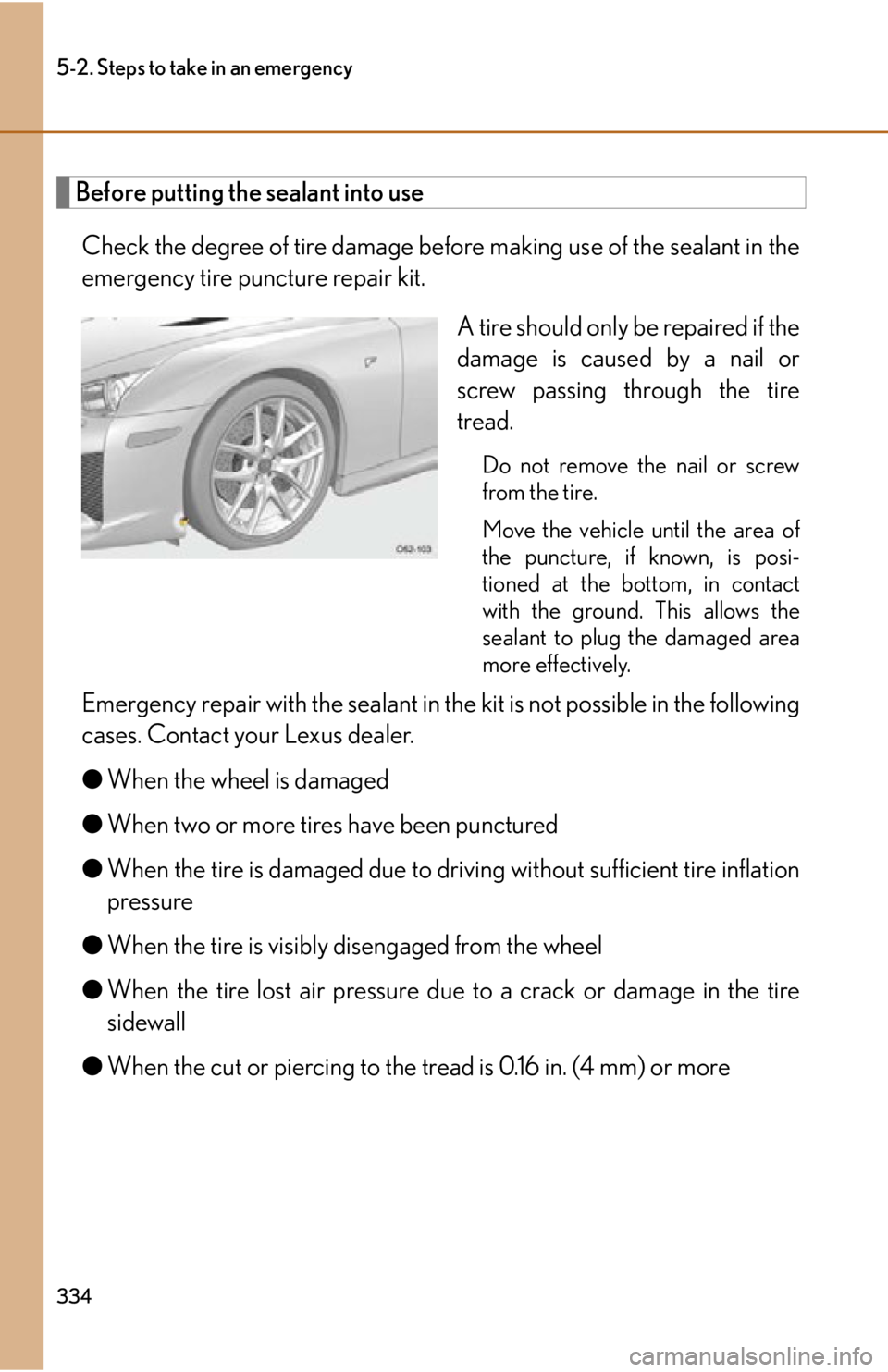Page 321 of 420

5
When trouble arises
319
5-2. Steps to take in an emergency
CAUTION
■When the electric power steering system warning light comes on
The steering wheel may become extremely heavy.
If the steering wheel becomes heavier than usual when operating, hold firmly and
operate using more force than usual.
■If the tire pressure warning light comes on
Be sure to observe the following precaution s. Failure to do so could cause a loss of
vehicle control and result in death or serious injury.
●Stop your vehicle in a safe place as soon as possible. Adjust the tire inflation pres-
sure immediately.
●If the tire pressure warning light comes on even after tire inflation pressure adjust-
ment, it is probable that you have a flat tire. Check the tires. If a tire is flat, tempo-
rarily repair the tire using the em ergency tire puncture repair kit ( P. 3 3 2 ) a n d
then have the tire repaired or replaced by the nearest Lexus dealer.
●Avoid abrupt maneuvering and braking. If the vehicle tires deteriorate, you could
lose control of the steering wheel or the brakes.
■If a blowout or sudden air leakage should occur
The tire pressure warning system may not activate immediately.
Page 322 of 420

320
5-2. Steps to take in an emergency
CAUTION
■Maintenance of the tires
Each tire, including the spare (if provided), should be checked monthly when cold
and inflated to the inflation pressure re commended by the vehicle manufacturer on
the vehicle placard or tire inflation pressu re label (tire and load information label).
(If your vehicle has tires of a different size than the size indicated on the vehicle
placard or tire inflation pressure label [tire and load information label], you should
determine the proper tire inflation pressure for those tires.)
As an added safety feature, your vehicl e has been equipped with a tire pressure
monitoring system (TPMS-tire pressure warning system) that illuminates a low tire
pressure telltale (tire pressure warning light) when one or more of your tires is sig-
nificantly under-inflated. Accordingly, when the low tire pressure telltale (tire pres-
sure warning light) illuminates, you should stop and check your tires as soon as
possible, and inflate them to the proper pressure. Driving on a significantly under-
inflated tire causes the tire to overheat and can lead to tire failure. Under-inflation
also reduces fuel efficiency and tire tread life, and may affect the vehicle's handling
and stopping ability.
Please note that the TPMS (tire pressure warning system) is not a substitute for
proper tire maintenance, and it is the driv er's responsibility to maintain correct tire
pressure, even if under-inflation has not reached the level to trigger illumination of
the TPMS low tire pressure telltale (tire pressure warning light).
Your vehicle has also been equipped with a TPMS (tire pressure warning system)
malfunction indicator to indicate when th e system is not operating properly. The
TPMS (tire pressure warning system) malfunction indicator is combined with the
low tire pressure telltale (tire pressure warning light). When the system detects a
malfunction, the telltale will flash for approximately one minute and then remain
continuously illuminated. This sequence will continue upon subsequent vehicle
start-ups as long as the malfunction exists . When the malfunction indicator is illumi-
nated, the system may not be able to detect or signal low tire pressure as intended.
TPMS (tire pressure warning system) malfunctions may occur for a variety of rea-
sons, including the installation of replacem ent or alternate tires or wheels on the
vehicle that prevent the TPMS (tire pres sure warning system) from functioning
properly. Always check the TPMS (tire pressure warning system) malfunction tell-
tale after replacing one or more tires or wheels on your vehicle to ensure that the
replacement or alternate tires and wheels allow the TPMS (tire pressure warning
system) to continue to function properly.
Page 334 of 420
332
5-2. Steps to take in an emergency
If you have a flat tire
The LFA is equipped with an emergency tire puncture repair kit, not a spare
tire.
A puncture caused by a nail or screw passing through the tire tread can be
repaired temporarily with the emerge ncy tire puncture repair kit. When
replacing the repaired tire, consult your Lexus dealer or tire dealer.
■Before repairing the tire
●Stop the vehicle in a safe place on a hard, flat surface.
● Set the parking brake.
● Select 1st gear or Reverse.
● Stop the engine.
● Turn on the emergency flashers.
■ Contents
Compressor
Sealant
Injection hose
Extension hose (for extracting
the sealant) Valve core tool
Valve core (spare)
Stickers
Page 336 of 420

334
5-2. Steps to take in an emergency
Before putting the sealant into useCheck the degree of tire damage befo re making use of the sealant in the
emergency tire puncture repair kit.
A tire should only be repaired if the
damage is caused by a nail or
screw passing through the tire
tread.
Do not remove the nail or screw
from the tire.
Move the vehicle until the area of
the puncture, if known, is posi-
tioned at the bottom, in contact
with the ground. This allows the
sealant to plug the damaged area
more effectively.
Emergency repair with the sealant in the kit is not possible in the following
cases. Contact your Lexus dealer.
● When the wheel is damaged
● When two or more tires have been punctured
● When the tire is damage d due to driving without sufficient tire inflation
pressure
● When the tire is visibly disengaged from the wheel
● When the tire lost air pressure due to a crack or damage in the tire
sidewall
● When the cut or piercing to the tread is 0.16 in. (4 mm) or more
Page 340 of 420
338
5-2. Steps to take in an emergency
Check the specified inflation pressure. (P. 366)
Turn the compressor switch “ON”
and fill the tire with air until the
specified inflation pressure is
reached.
Turn the switch “OFF” when the
pressure gauge connected to the
hose reads the specified pressure.
If the inflation pressure is not
attained within 8 minutes, emer-
gency repair is not possible due to
severe damage. Contact your
Lexus dealer.
After completely filling the tire with air, disconnect the hose from
the tire valve and the compress or power plug from the power
outlet.
To spread the liquid sealant ev enly in the tire, immediately drive
for about 3 miles (5 km) or 10 minutes.
Drive cautiously at a moderate speed, avoiding sudden starts, sudden
braking, and abrupt steering maneuvers.
After driving about 3 miles (5 km)
or 10 minutes, stop your vehicle in
a safe place and reconnect the
compressor.
STEP 14
STEP 15
STEP 16
STEP 17
STEP 18
STEP 19
Page 341 of 420
5
When trouble arises
339
5-2. Steps to take in an emergency
Read the inflation pressure on the
pressure gauge.
If the pressure is 18 psi (130 kPa,
1.3 kgf/cm
2 or bar) or above:
Fill the tire with air using the com-
pressor until the specified inflation
pressure is reached.
If the pressure is less than 18 psi
(130 kPa, 1.3 kgf/cm
2 or bar):
The emergency repair that has
been performed is not safe for use
as damage to the ti re is too severe.
Do not continue to drive the vehi-
cle. Contact your Lexus dealer.
Store the kit and then attach the
sticker as shown.
Taking precautions to avoid sud-
den braking and sharp turns, drive
carefully at under 50 mph (80
km/h) to the nearest Lexus dealer
or tire dealer for tire repair or
replacement.
STEP 20
STEP21
Page 342 of 420

340
5-2. Steps to take in an emergency
■Sealant
●One tire can be repaired using the bottle of sealant stored in the emergency tire
puncture repair kit.
●The sealant can be used when the outside temperature is from -22°F (-30°C)
to 140°F (60°C).
●When the outside temperature is low, the viscosity of the sealant becomes high
and it will be more difficult to inject th e sealant. In this case, warm the sealant in
the vehicle before using it.
●The sealant has a limited lifespan. The expi ration date is marked on the bottle.
The sealant should be replaced before the expiration date. Contact your Lexus
dealer.
●If the sealant gets on your clothes, it may stain.
●After using the sealant, bring the empty bottle of sealant to your Lexus dealer
and purchase a new bottle. Keep the ne w bottle of sealant in your vehicle.
■Compressor
●The compressor is a pneumatic filling type for passenger vehicles.
●When the compressor is operating, a loud operating noise will be produced.
This does not indicate a malfunction.
■The wheel of a tire that has been repaired
If you remove the sealant adhering to the wheel with a rag, you can reuse the wheel.
■The valve of a tire that has been repaired
●After a tire is repaired with the emergency tire puncture repair kit, the tire pres-
sure warning valve and transm itter should be replaced.
●After a tire is repaired with the emergency tire puncture repair kit, even if the
tire inflation pressure is at the recommended level, the tire pressure warning
light may come on/flash.
Page 343 of 420

5
When trouble arises
341
5-2. Steps to take in an emergency
CAUTION
■Precaution for children
Keep the emergency tire puncture repair kit out of the reach of children and store it
properly.
■Sealant precautions
●The sealant in the emergency tire puncture repair kit is not for human consump-
tion.
If the sealant is consumed, drink a large quantity of water and get medical atten-
tion immediately.
●If sealant gets in your eyes or on your skin, thoroughly wash with a large quantity
of water. If necessary, get medical attention.
■When fixing the flat tire
●Stop your vehicle in a safe and flat area.
●If force is used to turn the valve core tool while air remains in the tire, special care
should be taken because the valve core could fly out.
●Be careful, as sealant may fly out if you shake the bottle with the hose installed.
●If the hose is not securely installed, sealant may leak out when filling.
●Connect the valve and hose securely with the tire installed on the vehicle.
●Be careful handling the compressor, as parts of the compressor get hot during
operation. Some parts of the compressor may remain hot after use.
●Do not attach the vehicle speed warning sticker to an area other than the one
indicated. If the sticker is attached to an area where an SRS airbag is located,
such as the pad of the steering wheel, it may prevent the SRS airbag from operat-
ing properly.
■Driving to spread the liquid sealant evenly
Drive cautiously at a moderate speed, avoi ding sudden starts, sudden braking, and
abrupt steering maneuvers.